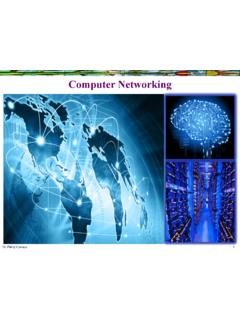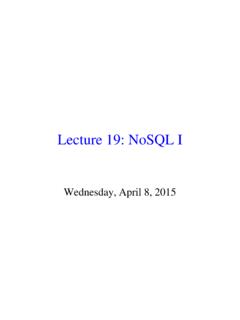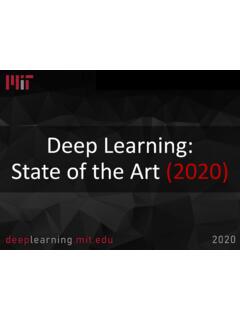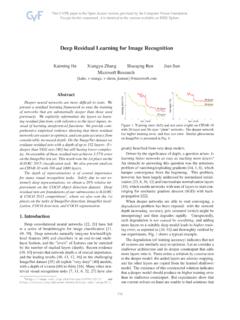Transcription of Model-Agnostic Meta-Learning for Fast Adaptation of …
1 Model-Agnostic Meta-Learning for fast Adaptation of deep Networks Chelsea Finn 1 Pieter Abbeel 1 2 Sergey Levine 1. Abstract the form of computation required to complete the task. We propose an algorithm for Meta-Learning that In this work, we propose a Meta-Learning algorithm that is Model-Agnostic , in the sense that it is com- is general and Model-Agnostic , in the sense that it can be [ ] 18 Jul 2017. patible with any model trained with gradient de- directly applied to any learning problem and model that scent and applicable to a variety of different is trained with a gradient descent procedure. Our focus learning problems, including classification, re- is on deep neural network models, but we illustrate how gression, and reinforcement learning .
2 The goal our approach can easily handle different architectures and of Meta-Learning is to train a model on a vari- different problem settings, including classification, regres- ety of learning tasks, such that it can solve new sion, and policy gradient reinforcement learning , with min- learning tasks using only a small number of train- imal modification. In Meta-Learning , the goal of the trained ing samples. In our approach, the parameters of model is to quickly learn a new task from a small amount the model are explicitly trained such that a small of new data, and the model is trained by the meta-learner number of gradient steps with a small amount to be able to learn on a large number of different tasks. of training data from a new task will produce The key idea underlying our method is to train the model 's good generalization performance on that task.
3 In initial parameters such that the model has maximal perfor- effect, our method trains the model to be easy mance on a new task after the parameters have been up- to fine-tune. We demonstrate that this approach dated through one or more gradient steps computed with leads to state-of-the-art performance on two few- a small amount of data from that new task. Unlike prior shot image classification benchmarks, produces Meta-Learning methods that learn an update function or good results on few-shot regression, and acceler- learning rule (Schmidhuber, 1987; Bengio et al., 1992;. ates fine-tuning for policy gradient reinforcement Andrychowicz et al., 2016; Ravi & Larochelle, 2017), our learning with neural network policies. algorithm does not expand the number of learned param- eters nor place constraints on the model architecture ( by requiring a recurrent model (Santoro et al.))
4 , 2016) or a Siamese network (Koch, 2015)), and it can be readily com- 1. Introduction bined with fully connected, convolutional, or recurrent neu- learning quickly is a hallmark of human intelligence, ral networks. It can also be used with a variety of loss func- whether it involves recognizing objects from a few exam- tions, including differentiable supervised losses and non- ples or quickly learning new skills after just minutes of differentiable reinforcement learning objectives. experience. Our artificial agents should be able to do the The process of training a model 's parameters such that a same, learning and adapting quickly from only a few exam- few gradient steps, or even a single gradient step, can pro- ples, and continuing to adapt as more data becomes avail- duce good results on a new task can be viewed from a fea- able.
5 This kind of fast and flexible learning is challenging, ture learning standpoint as building an internal representa- since the agent must integrate its prior experience with a tion that is broadly suitable for many tasks. If the internal small amount of new information, while avoiding overfit- representation is suitable to many tasks, simply fine-tuning ting to the new data. Furthermore, the form of prior ex- the parameters slightly ( by primarily modifying the top perience and new data will depend on the task. As such, layer weights in a feedforward model ) can produce good for the greatest applicability, the mechanism for learning to results. In effect, our procedure optimizes for models that learn (or Meta-Learning ) should be general to the task and are easy and fast to fine-tune, allowing the Adaptation to 1.
6 University of California, Berkeley 2 OpenAI. Correspondence happen in the right space for fast learning . From a dynami- to: Chelsea Finn cal systems standpoint, our learning process can be viewed as maximizing the sensitivity of the loss functions of new Proceedings of the 34 th International Conference on Machine tasks with respect to the parameters: when the sensitivity learning , Sydney, Australia, PMLR 70, 2017. Copyright 2017. by the author(s). is high, small local changes to the parameters can lead to Model-Agnostic Meta-Learning for fast Adaptation of deep Networks large improvements in the task loss. Meta-Learning learning / Adaptation The primary contribution of this work is a simple model - and task-agnostic algorithm for Meta-Learning that trains L3.
7 A model 's parameters such that a small number of gradi- ent updates will lead to fast learning on a new task. We L2. L1 3 . demonstrate the algorithm on different model types, includ- ing fully connected and convolutional networks, and in sev- eral distinct domains, including few-shot regression, image 1 2 . classification, and reinforcement learning . Our evaluation Figure 1. Diagram of our Model-Agnostic Meta-Learning algo- shows that our Meta-Learning algorithm compares favor- rithm (MAML), which optimizes for a representation that can ably to state-of-the-art one-shot learning methods designed quickly adapt to new tasks. specifically for supervised classification, while using fewer parameters, but that it can also be readily applied to regres- In our Meta-Learning scenario, we consider a distribution sion and can accelerate reinforcement learning in the pres- over tasks p(T ) that we want our model to be able to adapt ence of task variability, substantially outperforming direct to.
8 In the K-shot learning setting, the model is trained to pretraining as initialization. learn a new task Ti drawn from p(T ) from only K samples drawn from qi and feedback LTi generated by Ti . During 2. Model-Agnostic Meta-Learning meta-training, a task Ti is sampled from p(T ), the model is trained with K samples and feedback from the corre- We aim to train models that can achieve rapid Adaptation , a sponding loss LTi from Ti , and then tested on new samples problem setting that is often formalized as few-shot learn- from Ti . The model f is then improved by considering how ing. In this section, we will define the problem setup and the test error on new data from qi changes with respect to present the general form of our algorithm. the parameters.
9 In effect, the test error on sampled tasks Ti serves as the training error of the Meta-Learning process. At Meta-Learning Problem Set-Up the end of meta-training, new tasks are sampled from p(T ), and meta-performance is measured by the model 's perfor- The goal of few-shot Meta-Learning is to train a model that mance after learning from K samples. Generally, tasks can quickly adapt to a new task using only a few datapoints used for meta-testing are held out during meta-training. and training iterations. To accomplish this, the model or learner is trained during a Meta-Learning phase on a set of tasks, such that the trained model can quickly adapt to A Model-Agnostic Meta-Learning Algorithm new tasks using only a small number of examples or trials.
10 In contrast to prior work, which has sought to train re- In effect, the Meta-Learning problem treats entire tasks as current neural networks that ingest entire datasets (San- training examples. In this section, we formalize this meta- toro et al., 2016; Duan et al., 2016b) or feature embed- learning problem setting in a general manner, including dings that can be combined with nonparametric methods at brief examples of different learning domains. We will dis- test time (Vinyals et al., 2016; Koch, 2015), we propose a cuss two different learning domains in detail in Section 3. method that can learn the parameters of any standard model We consider a model , denoted f , that maps observa- via Meta-Learning in such a way as to prepare that model tions x to outputs a.













